Shashikala: The exemplary second fiddle

Over the years Shashikala mastered the art of playing the second fiddle with her noteworthy performances
Born in a small town, Solapur in Maharashtra, Shashikala had exhibited talent from an early age whether it was working as an artiste in a village fair at the age of five or moving to Mumbai to act in films at 11.
However, that shift had happened due to a rough stroke destiny instead of choice. Struggling to make ends meet and motivated by the friends and relatives, her father brought her to Mumbai at the young age of 11 to act in films which marked the beginning of the next phase of her life.
“My father was told by many, ‘Baby is so beautiful and acts so well. You must get her into films’, that’s how I came to Mumbai,” the actress had said in an interview in 2015.
Her passion for acting eventually led her to work in over 100 films. Despite being brilliant at her work she was only offered second leads or bit roles while other actresses of her time graduated to lead roles. However, undeterred, over the years Shashikala mastered the art of playing the second fiddle with her noteworthy performances and edgy characters.
Her first role on the silver screen was the small part she played in a qawwali song in the movie Zeenat (1945) for which she earned INR 25. After the success of Zeenat, Shashikala went on to work for acclaimed directors like P.N Arora, Amiya Chakravarti of the period, while acting opposite actors like Karan Devgn and Agha.
Whether it was the role of Rama, the character of daughter to a Brahmin family that chooses to adopt and raise another girl, the lower-caste Sujata in Bimal Roy’s Sujata (1959), or Jaswanti, a cunning sister-in-law, an out-and-out negative part she played in the 1962 film Aarti, or the characters of scheming mothers-in-law, conspiratorial queen mothers and brothel madams she played in her later years. The diverse roles she played throughout her career with equal prowess and flair inspired actors throughout generations.
Her performance in Aarti also got both the audience and the critics talking. She was flooded with offers and worked in Junglee (1961), Anupama (1966), Phool Aur Pathar (1966), Ayi Milan ki Bela (1964), Gumrah (1963) and Waqt (1965) back-to-back. She was also nominated for the Filmfare awards five times and won twice for Aarti and Gumrah.
Being an independent and fierce woman she had fought through all that life threw at her, from a deprived childhood, troubled marriage, an abusive relationship to mourning the death of her daughter. Victorious against all these hardships she returned to Bollywood for a second innings and worked in various films like Sargam (1979), Khubsoorat (1980), Dulhan Wohi Jo Piya Man Bhaye (1977), Aahista Aahista (1981) and Swami (1977) which were all jubilee hits and like that she was back in the race.
But destiny was not done with playing her a bad hand. Right after the shooting of Ghar Ghar ki Kahaani in 1988, her restlessness and anger returned due to her personal problems. Feeling lonely and hollow she found her way to Mother Theresa and joined her NGO. There cleaning toilets, removing maggots from wounds and changing dressings, mopping the floors gave her the solace she was searching for.
Back in control of her life again, she returned to Bollywood for another innings and worked in big banner hits like Mujhse Shaadi Karogi(2004), Kabhi Khushi Kabhie Gham (2001) and Baadshah (1999). This time she also worked in hit television series like Jeena Isi Ka Naam Apnapan, Dil Deke Dekho and Son Pari. She was also awarded the Padma Shri for her contribution to Indian cinema in 2007.
Despite setbacks in her professional and personal life, Shashikala excelled at everything she did. From a good woman to the villain of the piece. And she leaves behind a rich legacy of art behind her and became an inspiration to all those who are forced to play second fiddle throughout their lives.









